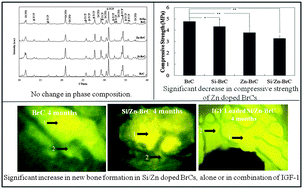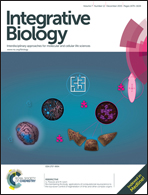IGF-loaded silicon and zinc doped brushite cement: physico-mechanical characterization and in vivo osteogenesis evaluation†
Abstract
Dopants play critical roles in controlling the physical, mechanical, degradation kinetics, and in vivo properties of calcium phosphates. The aim of the present study was to evaluate the effects of silicon (Si) and zinc (Zn) dopants on the physico-mechanical and in vivo osteogenesis properties of brushite cements (BrCs) alone and in combination with insulin like growth factor 1 (IGF-1). Addition of 0.5 wt% Si did not alter the setting time, β-TCP content, and compressive strength of BrCs significantly; however, 0.25 wt% Zn incorporation was accompanied by a significant decrease in mechanical strength from 4.78 ± 0.21 MPa for pure BrC to 3.78 ± 0.59 MPa and 3.28 ± 0.22 MPa for Zn-BrC and Si/Zn-BrC, respectively. The in vivo bone regeneration properties of doped BrCs alone and in combination with IGF-1 were assessed and compared using chronological radiography, histology, scanning electron microscopy and fluorochrome labeling at 2 and 4 months post implantation in a rabbit femoral defect model. Based on in vivo characterization focusing on osteogenesis and vasculogenesis, Si-BrC and Si/Zn-BrC showed the best performance followed by Zn-BrC and pure BrCs. Addition of IGF-1 further improved bone regeneration. Our findings confirm that addition of Si and/or Zn alters the physico-mechanical properties of BrCs and promotes the early stage in vivo osseointegration and bone remodeling properties.


 Please wait while we load your content...
Please wait while we load your content...